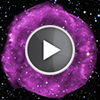CXC Home | Search | Help | Image Use Policy | Latest Images | Privacy | Accessibility | Glossary | Q&A
Tour of Tycho's Supernova Remnant
Quicktime MPEG With closed-captions (at YouTube)
When the star that created this supernova remnant exploded in 1572, it was so bright that it was visible during the day. And though he wasn't the first or only person to observe this stellar spectacle, the Danish astronomer Tycho Brahe wrote a book about his extensive observations of the event, gaining the honor of it being named after him.
In modern times, astronomers have observed the debris field from this explosion - what is now known as Tycho's supernova remnant - with many telescopes including the Chandra X-ray Observatory. Since much of the material being flung out from the shattered star has been heated by shock waves - similar to sonic booms from supersonic planes - passing through it, the remnant glows strongly in X-ray light.
Astronomers used Chandra observations from 2000 through 2015 to create the longest movie of the Tycho remnant's X-ray evolution over time - the first such movie of Tycho ever made. This movie shows that the expansion from the explosion is still continuing about 450 years after Tycho Brahe and others witnessed the event.
By combining the X-ray data with some 30 years of observations in radio waves with the VLA, also producing a movie, astronomers have used these data to learn new things about this supernova and its remnant.
So grab some popcorn and enjoy this early summer movie. It will be unlike any you'll see in the theater!
[Runtime: 02:32]
Quicktime MPEG With closed-captions (at YouTube)
When the star that created this supernova remnant exploded in 1572, it was so bright that it was visible during the day. And though he wasn't the first or only person to observe this stellar spectacle, the Danish astronomer Tycho Brahe wrote a book about his extensive observations of the event, gaining the honor of it being named after him.
In modern times, astronomers have observed the debris field from this explosion - what is now known as Tycho's supernova remnant - with many telescopes including the Chandra X-ray Observatory. Since much of the material being flung out from the shattered star has been heated by shock waves - similar to sonic booms from supersonic planes - passing through it, the remnant glows strongly in X-ray light.
Astronomers used Chandra observations from 2000 through 2015 to create the longest movie of the Tycho remnant's X-ray evolution over time - the first such movie of Tycho ever made. This movie shows that the expansion from the explosion is still continuing about 450 years after Tycho Brahe and others witnessed the event.
By combining the X-ray data with some 30 years of observations in radio waves with the VLA, also producing a movie, astronomers have used these data to learn new things about this supernova and its remnant.
So grab some popcorn and enjoy this early summer movie. It will be unlike any you'll see in the theater!
[Runtime: 02:32]
(Credit: NASA/CXC/A. Hobart)
Chandra X-ray Time-lapse of Tycho's Supernova Remnant
Quicktime MPEG
By combining observations from over 15 years with the Chandra X-ray Observatory and 30 years with the Very Large Array, scientists have been able to learn new things about Tycho's supernova remnant and the explosion that created it. This time-lapse movie shows the expansion of the Tycho remnant, allowing a detailed study of how the debris field is expanding. In a series of five images from Chandra taken between 2000 and 2015, low-energy X-rays are red, the medium band of X-rays is green, and the highest-energy X-rays Chandra detected are blue.
[Runtime: 00:02]
Quicktime MPEG
By combining observations from over 15 years with the Chandra X-ray Observatory and 30 years with the Very Large Array, scientists have been able to learn new things about Tycho's supernova remnant and the explosion that created it. This time-lapse movie shows the expansion of the Tycho remnant, allowing a detailed study of how the debris field is expanding. In a series of five images from Chandra taken between 2000 and 2015, low-energy X-rays are red, the medium band of X-rays is green, and the highest-energy X-rays Chandra detected are blue.
[Runtime: 00:02]
(Credit: NASA/CXC/GSFC/B.Williams et al;)
Stills
Radio Time-lapse of Tycho's Supernova Remnan
Quicktime MPEG
With some 30 years of observations in radio waves with the VLA, astronomers have also produced a movie, using three different images. Astronomers have used the X-ray and radio data to learn new things about this supernova and its remnant.
[Runtime: 00:02]
Quicktime MPEG
With some 30 years of observations in radio waves with the VLA, astronomers have also produced a movie, using three different images. Astronomers have used the X-ray and radio data to learn new things about this supernova and its remnant.
[Runtime: 00:02]
(Credit: NSF/NRAO/VLA)
Stills
Return to Tycho's Supernova Remnant (May 12, 2016)





